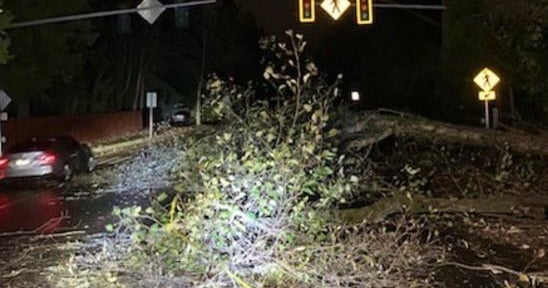Residents rescued as mud inundates California burn areas
LOS ANGELES -- Authorities say eight people have been killed by mudslides that have destroyed homes in Southern California during a powerful winter storm that dropped record rain across the state. Their identities are being withheld pending family notification.
Santa Barbara County Fire Department Capt. Dave Zaniboni says the bodies were found in mud and debris during rescue operations Santa Barbara County.
Crews rescued other residents from inundated homes as mud and debris from wildfire-scarred hillsides flowed through neighborhoods. Helicopters were being used even during the downpours because roads were blocked, Santa Barbara County spokeswoman Amber Anderson said.
"The primary issue right now is access. We've got trees and power lines down," she said.
There were reports of injuries, but Anderson didn't immediately know how many or the extent. She said "multiple" residents had been rescued and more were calling for help in Montecito and Carpinteria. Thousands were without power.
Zaniboni says crews are making rescues across the foothill enclave of Montecito northwest of Los Angeles where active searches are underway as rain continues to fall from a huge winter storm that has soaked much of the state.
Crews are working to clear debris from roads across greater Los Angeles, including a 30 mile stretch of U.S. 101 that was shut down along the border of Santa Barbara and Ventura counties. According to CBS Los Angeles, the flooding and mud flows, which were knee deep in some areas, left several big rigs and cars stranded in the closed portion of the freeway.
One police cruiser became encased in mud near the La Tuna Canyon area.
In Montecito, firefighters rescued two men and a woman from flood debris. Authorities say multiple rescues are underway throughout the area.
Resident Eric Trautwein captured what he believes was an explosion on security footage. Trautwein shared the video on Twitter.
According to CBS News correspondent Carter Evans, "boulders the size of cars" were coming down a small creek in Montecito early Tuesday morning. Thick mud blocked a heavily traveled intersection in the area.
Evacuation orders were issued Monday over fears of mudslides in those foothill neighborhoods where the state's largest-ever fire raged last month. As of Tuesday morning, more than 20,000 people were placed under evacuation orders northwest of Los Angeles.
The threat of mudslides is vast, spreading from Santa Barbara all the way to Duarte.
CBS Los Angeles reports the possibility of toxic waste from burned out homes and cars are also a concern for lower-lying homeowners.
Water and debris in lanes brought coastal U.S. 101 to a standstill, and traffic accidents on rain-slicked roadways across the region slowed the morning commute to a crawl. That's where thousands of residents evacuated Monday over fears of destructive mudslides in areas where the state's largest-ever fire raged last month.
The first significant storm of the season soaked much of the state. Record-breaking rain fell on the San Francisco Bay region before the storm largely passed overnight, leaving diminishing showers there before dawn Tuesday. Stormy weather continued to the east in the Central Valley and Sierra Nevada.
Downtown San Francisco had a record 3.15 inches of rain on Monday, smashing the old mark of 2.36 inches set in 1872 and making it the city's 16th wettest day since 1849, the National Weather Service said.
To the south, a staggering 9.6 inches of rain fell on Mining Ridge on the Big Sur coast. Highway 1, still not recovered from last winter's damaging rains, suffered new blockages.
Forecasters issued flash flood warnings and predicted that the cold front with powerful winds could bring higher rain totals to downtown Los Angeles than recorded over the past 10 months. A winter weather advisory was in place for mountain areas, where officials warned motorists to prepare for difficult travel conditions, including gusty winds, low visibility and snow-covered roads.
A yearslong drought eased in the state last spring, but Northern California had a dry start to winter and hardly any measurable rain fell in the south over the past six months. The extremely dry conditions and high winds last year led to some of the most destructive blazes on both ends of the state.



